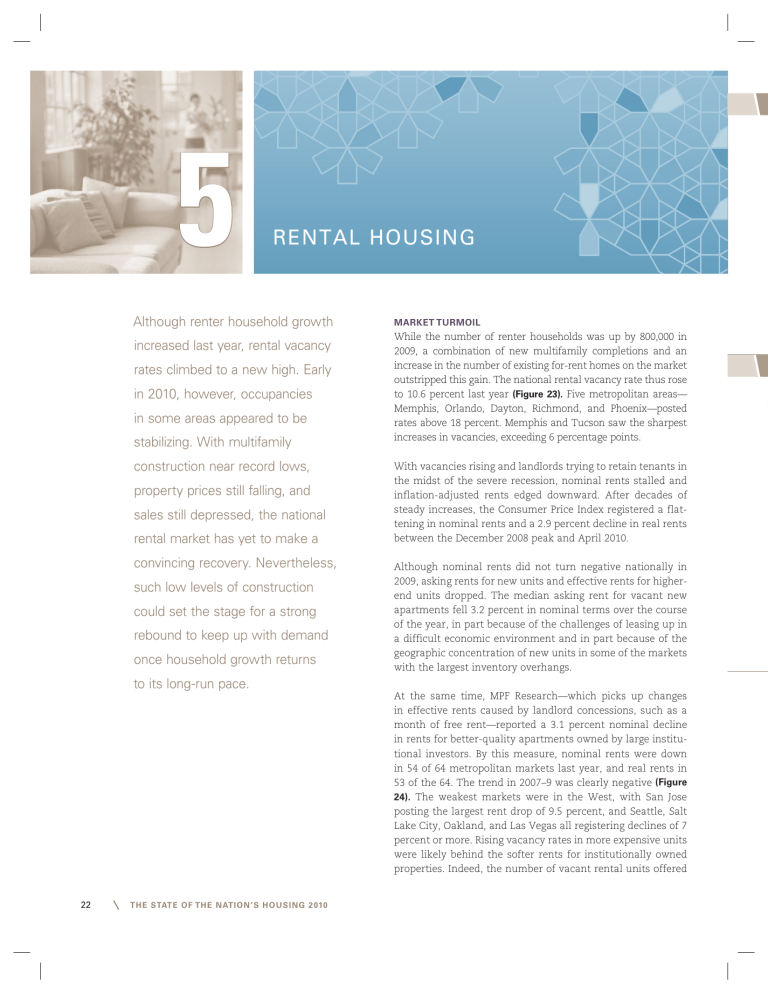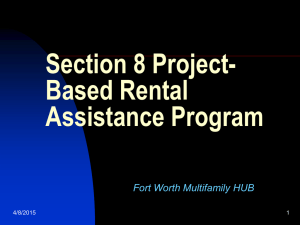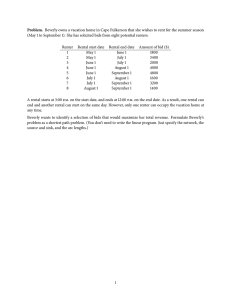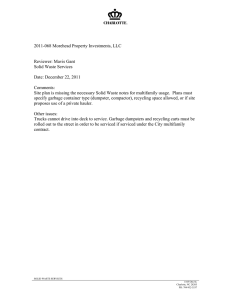5 rental Housing Although renter household growth increased last year, rental vacancy

22
5
rental Housing
Although renter household growth increased last year, rental vacancy rates climbed to a new high. Early in 2010, however, occupancies in some areas appeared to be stabilizing. With multifamily construction near record lows, property prices still falling, and sales still depressed, the national rental market has yet to make a convincing recovery. Nevertheless, such low levels of construction could set the stage for a strong rebound to keep up with demand once household growth returns to its long-run pace.
market turmoil
While the number of renter households was up by 800,000 in
2009, a combination of new multifamily completions and an increase in the number of existing for-rent homes on the market outstripped this gain. The national rental vacancy rate thus rose to 10.6 percent last year (figure 23).
Five metropolitan areas—
Memphis, Orlando, Dayton, Richmond, and Phoenix—posted rates above 18 percent. Memphis and Tucson saw the sharpest increases in vacancies, exceeding 6 percentage points.
With vacancies rising and landlords trying to retain tenants in the midst of the severe recession, nominal rents stalled and inflation-adjusted rents edged downward. After decades of steady increases, the Consumer Price Index registered a flattening in nominal rents and a 2.9 percent decline in real rents between the December 2008 peak and April 2010.
Although nominal rents did not turn negative nationally in
2009, asking rents for new units and effective rents for higherend units dropped. The median asking rent for vacant new apartments fell 3.2 percent in nominal terms over the course of the year, in part because of the challenges of leasing up in a difficult economic environment and in part because of the geographic concentration of new units in some of the markets with the largest inventory overhangs.
At the same time, MPF Research—which picks up changes in effective rents caused by landlord concessions, such as a month of free rent—reported a 3.1 percent nominal decline in rents for better-quality apartments owned by large institutional investors. By this measure, nominal rents were down in 54 of 64 metropolitan markets last year, and real rents in
53 of the 64. The trend in 2007–9 was clearly negative (figure
24).
The weakest markets were in the West, with San Jose posting the largest rent drop of 9.5 percent, and Seattle, Salt
Lake City, Oakland, and Las Vegas all registering declines of 7 percent or more. Rising vacancy rates in more expensive units were likely behind the softer rents for institutionally owned properties. Indeed, the number of vacant rental units offered tHe state of tHe nation’s Housing 2010
FIGURE 23
9.0
8.5
8.0
10.5
10.0
9.5
Rental Vacancies Have Soared …
Rental Vacancy Rate (Percent)
11.0
2005 2006 2007
Source: US Census Bureau, Housing Vacancy Survey.
2008 2009
FIGURE 24
100
90
80
70
60
50
40
30
20
10
0
After Only Two Years, Softening Rents Spread to Nearly All Major Metropolitan Areas
Share of Metros in Each Rent Change Category (Percent)
2007 2008 2009
�
�
0–5% Decrease
More than 5% Decrease
� More than 5% Increase
� 0–5% Increase
Notes: Data include only the 56 (out of 64) metros that reported rents in all three years. Changes are in average effective rents for investment-grade properties, measured fourth quarter to fourth quarter.
Source: JCHS tabulations of MPF Research data.
… Despite an Increase in Renter Households
Annual Change (Thousands)
1,000
800
600
400
200
0
-200
2005 2006 2007
� Renter Households � Vacant Rental Units
2008 2009
FIGURE 23
9.0
8.5
8.0
10.5
10.0
9.5
Rental Vacancies Have Soared …
Rental Vacancy Rate (Percent)
11.0
2005 2006 2007
Source: US Census Bureau, Housing Vacancy Survey.
2008 2009
… Despite an Increase in Renter Households
Annual Change (Thousands)
1,000
800
600
400
200
0
-200
2005 2006 2007
� Renter Households � Vacant Rental Units
2008 2009
FIGURE 24
After Only Two Years, Softening Rents Spread to Nearly All Major Metropolitan Areas
Share of Metros in Each Rent Change Category (Percent)
100
90
80
70
60
50
40
30
20
10
0
�
�
2007
0–5% Decrease
More than 5% Decrease
2008
� More than 5% Increase
� 0–5% Increase
2009
Notes: Data include only the 56 (out of 64) metros that reported rents in all three years. Changes are in average effective rents for investment-grade properties, measured fourth quarter to fourth quarter.
Source: JCHS tabulations of MPF Research data.
for $1,500 or more per month shot up 23 percent while the number offered for less than $600 was virtually unchanged from a year earlier.
The increase in vacancies was concentrated primarily in larger properties. Units in buildings with 10 or more apartments, which make up slightly less than a third of the rental stock, contributed nearly two-thirds of the 379,000 jump in overall vacancies from the fourth quarter of 2008 to the fourth quarter of 2009. Vacancies among single-family rentals, which make up 35 percent of the stock, dropped by 46,000 units over this period.
investor PullbaCk
Both sales and starts of multifamily properties came close to a standstill in 2009. Real Capital Analytics reports that just 180,000 units in properties worth at least $5 million were sold last year, compared with 941,000 at the 2006 peak.
Multifamily starts dropped from 284,000 units in 2008 to
109,000 in 2009—their lowest level on record. But because completions lagged starts, falling only from 301,000 to
274,000, the rental market has yet to register the full effects of the near-cessation of production.
Limited investor interest helped to drive down new construction. This was especially pronounced in the affordable rental market, where there was a sharp pullback in investor demand for federal low income housing tax credits. When several large financial institutions that had dominated the tax credit market swung from profit to loss in 2007, they no longer had taxable income to offset. As a result, affordable housing developments were stalled until two federal stopgap programs went into effect in the second half of 2009.
Prices of apartment properties fell again last year, although the pace of decline slowed. According to the NCREIF price index, rental property prices dropped 29.4 percent from their first-quarter 2008 peak through the fourth quarter of
2009. Over the course of the year, however, quarterly price declines eased from 9.6 percent to 2.9 percent. After sliding for most of the decade, the capitalization rate was up by roughly 1 percentage point in 2009, to 6 percent. These trends largely reflect investor demand for higher expected returns. Falling net operating incomes also contributed to the price declines, although they did recover slightly in the fourth quarter—suggesting that rental markets may have started to stabilize.
Joint Center for Housing studies of Harvard university 23
FIGURE 25
While Still Better than Single-Family Loans,
Performance of Multifamily Mortgages
Has Continued to Deteriorate
Share 60 or More Days Delinquent or in Foreclosure (Percent)
12
10
8
6
4
2
0
-1
2005:4 2006:4 2007:4 2008:4
� Single-Family � Fannie Mae Multifamily
� Multifamily CMBS � Freddie Mac Multifamily
Notes: Single-family loans include loans for 1- to 4-unit properties. Single-family delinquency rate is based on number of loans, while other rates are based on volume of loans. CMBS delinquencies include foreclosed properties owned by banks.
Sources: Mortgage Bankers Association, National Delinquency Survey and Commercial/Multifamily
Delinquency Rates; Moody’s Economy.com, CMBS Delinquency Tracker.
2009:4 eroding loan PerformanCe
Multifamily property prices topped out in 2008, two years after the peak in single-family prices. In addition, vacancies in the for-rent market did not jump until three years after the surge in the for-sale market. As a result, poor loan performance in the multifamily sector did not become apparent until 2009.
About 12.1 percent of multifamily loans are held in trusts for commercial mortgage-backed securities (CMBS). According to Moody’s Economy.com, the share of multifamily loans in
CMBS that were at least 60 days delinquent, in foreclosure, or post-foreclosure and owned by the issuing trusts (REO) jumped from 1 percent of balances outstanding in December
2007 to 12.9 percent in April 2010. As in the single-family market, performance of these private market loans was substantially worse than on the nearly 40.4 percent of multifamily debt owned or guaranteed by Fannie Mae and Freddie
Mac. Indeed, with severe delinquency rates of less than 1 percent, Fannie and Freddie multifamily loans outperformed
CMBS as well as single-family mortgages (figure 25).
Unless net operating income plus reserves is insufficient to cover debt and there is little hope values will bounce back, property owners generally continue to make loan payments even when their mortgage balances exceed the value of the properties. For lenders, however, a critical decision point arrives when loans come due. In these circumstances, they have an incentive to extend maturing loans because forcing repayment would likely result in default, impairing the lender’s capital. Maturing mortgages may also have built-in extension options, and most investor groups have considerable discretion over how to deal with borrowers that are unable to immediately refinance. As a result, lenders typically extend or modify multifamily mortgages that are underwater when they come due, thus limiting foreclosures in this market segment.
Lenders who do pick up small rental properties through foreclosures may push to remove tenants to avoid any liability and to make the buildings easier to sell. This eviction risk prompted passage of the Protecting Tenants at Foreclosure
Act of May 2009, requiring new owners of foreclosed properties to honor existing leases and provide at least 90 days notice prior to eviction. Lenders who take back larger multifamily buildings, however, are much more likely to hand the properties over to management companies in an effort to retain tenants and preserve as much of the cash flow as possible. Thus, tenants in larger bank-foreclosed buildings are at less risk of eviction, although they—like any renters in buildings whose owners are struggling financially—may still face problems from deferred maintenance.
Falling property values, high vacancy rates, and deteriorating loan performance have dampened the demand for credit and made it more difficult to get, especially for development.
While debt is more available for existing properties, underwriting terms have tightened. Multifamily loan originations by private CMBS conduits have dropped to essentially zero.
Meanwhile, HUD announced increases in the minimum required net worth for FHA-approved lenders. Other underwriting changes proposed for FHA-insured multifamily loans would raise debt service coverage ratios, reduce loan-to-cost ratios, and double construction contingencies and working capital escrows.
Fannie Mae and Freddie Mac stepped up their multifamily activity in 2007 to help ease the credit crisis. Although volumes fell in 2008 and 2009, their combined share of multifamily loans outstanding rose to 40 percent in 2009, up from
30 percent in 2006, as others left the market. But their share of the small-balance multifamily loan market remains modest. In 2006, Fannie and Freddie purchased a mere 5 percent of multifamily loans of $1.0–1.9 million but fully 27 percent of loans of $10 million or more.
Originations of multifamily loans stabilized, albeit at very low levels, after sizable drops in the fourth quarter of 2008 and first quarter of 2009. The Mortgage Bankers Association reports that multifamily originations were down 62 percent in
2008 and another 8 percent in 2009.
24 tHe state of tHe nation’s Housing 2010
FIGURE 26
10
8
6
14
12
4
2
0
Many of the Losses of Low-Cost Rentals
Are Permanent Rather than the Result of Tenure Switching or Rent Increases
Share of 1997 Units by Status in 2007 (Percent)
Less than $400 $400–599
Real Unit Rent
� Demolished or Otherwise Permanently Removed
� Switched Tenure to Owner Occupancy or Temporary Use
� Upgraded to Higher Rent Range
Notes: Changes for the $400–599 category are the net effect of units moving in and out of that rent range.
Rents are adjusted to 2007 dollars using the CPI-U for All Items.
Source: JCHS tabulations of the US Census Bureau, 1997 and 2007 American Housing Surveys.
As originations slid last year, nominal multifamily mortgage debt outstanding fell $5.9 billion to $897.5 billion. Meanwhile, multifamily debt outstanding owned or guaranteed by Ginnie
Mae, Freddie Mac, Fannie Mae, and the Federal Home Loan
Banks rose by roughly $20 billion, with nearly half of this increase in mortgage pools. This brought the total share of multifamily debt owned or guaranteed by these entities up to
49 percent.
$400–600, 5.6 percent for units with rents of $600–800, and 4.2 percent for units with rents above $800.
Most apartments renting for under $400 in 2007 were located outside of center cities, and in the South and Midwest. Fully 45 percent of these rentals were government subsidized. Tenants of low-cost units had a median income of just $12,000, and more than half were single persons living alone.
Preservation CHallenges
The loss of low-cost rental housing continues unabated.
Between 1997 and the most recent measure in 2007, the number of units with real rents under $400 including utilities—about what a household earning the full-time minimum wage could afford at 30 percent of income—fell by 244,000 to 6.6 million.
CHanging ComPosition of rental demand
With homeowner markets stressed, the number of renter households rose by 3.4 million—or nearly 10 percent—between
2004 and 2009. The upturn was most dramatic in the Midwest, where renter household growth surged from a 2 percent drop in 2000–4 to a 13.4 percent gain in 2004–9. The South added the largest number of renter households, posting a 1.2 million increase in 2004–9. This growth occurred despite a large falloff in both domestic migration (which has favored the South and
West) and international immigration.
The biggest contributor to the dwindling supply of low-cost rental housing is demolition and removal from the stock
(figure 26).
Of the units renting for under $400 in 1997, 13.4 percent were lost to demolition, disaster, or other reasons by 2007. Another 2.2 percent were lost to abandonment or conversion to nonresidential uses. By comparison, permanent loss rates were only 10.0 percent for units with rents of
Minority households have contributed most of the growth in renters. Hispanics and blacks each accounted for a quarter of the net increase in renter households in 2004–9, while
Asians contributed 9 percent (figure 27).
The minority share of renters thus reached 45.1 percent last year, with Hispanics accounting for 18.3 percent, blacks 19.6 percent, and Asians and all other minorities 7.2 percent.
FIGURE 26
10
8
6
14
12
4
2
0
Many of the Losses of Low-Cost Rentals
Are Permanent Rather than the Result of Tenure Switching or Rent Increases
Share of 1997 Units by Status in 2007 (Percent)
Less than $400 $400–599
Real Unit Rent
� Demolished or Otherwise Permanently Removed
� Switched Tenure to Owner Occupancy or Temporary Use
� Upgraded to Higher Rent Range
Notes: Changes for the $400–599 category are the net effect of units moving in and out of that rent range.
Rents are adjusted to 2007 dollars using the CPI-U for All Items.
Source: JCHS tabulations of the US Census Bureau, 1997 and 2007 American Housing Surveys.
Immigration is driving the changing composition of rental demand. Continuing the strong growth posted in the 1990s, the foreign-born share of renter households increased from
17.4 percent in 2000 to 19.6 percent in 2009. Indeed, the number of Hispanic renters has more than tripled from just 1.9 million in 1980 to 7.0 million.
With the share of minority renters rising, demand for larger and more child-friendly units is likely to increase. On average, minority renter households include 2.8 persons and white renter households include 2.1. Even controlling for age, minority renter households are larger. For example, among renters aged 35–44, minority households have an average of 3.2 people, compared with just 2.6 for whites. A major difference is in the number of children present. Among all renters under age 55, the average number of children is 1.1 per minority household but only 0.6 per white household.
Despite the growing presence of younger minority households, the share of all renter households headed by young adults declined 4.5 percent between 2000 and 2009. Nearly twothirds of renter growth was instead among households aged
45–64, reflecting the impact of the baby-boom generation.
Large increases in older renters in 2008 suggest that many
Joint Center for Housing studies of Harvard university 25
FIGURE 27
Minorities Contributed More than Half of the
Increase in Renter Households Since 2004
Renter Household Growth, 2004–9 (Percent)
25%
39% households may have switched from owning to renting as the housing crisis took hold. Since older renters tend to prefer larger multi-unit buildings, particularly those with elevators, demand for this type of housing may well increase over the coming decade as the baby boomers enter retirement.
2%
9%
Total: 3.4 Million
25%
� Hispanic
� Black
�
�
�
Asian
Other
White
Notes: White, black, Asian, and other householders are non-Hispanic. Hispanics may be of any race. Other includes multiracial householders.
Source: JCHS tabulations of the 2004 and 2009 IPUMS Current Population Surveys.
FIGURE 28
Changes in the Age Distribution of Households
Will Likely Lift Demand for Rental Housing
Over the Next Decade
Projected Renter Household Growth, 2010–20 (Thousands)
1,500
1,250
1,000
750
500
250
0
-250
15–24 25–34 35–44 45–54 55–64
Age of Householder
� Assuming Low Immigration � Assuming High Immigration
65–74 75 and
Over
Notes: High immigration projection assumes immigration rises from 1.1 million in 2005 to 1.5 million in 2020, as estimated by the Census Bureau's 2008 population projections. Low immigration projection assumes immigration is half the Census Bureau's projected totals.
Source: JCHS household projections.
The ouTlook
As in the homeowner market, several opposing forces are at work in the rental market. On the downside, high unemployment—especially among minorities and the young—is a drag on demand. In addition, the narrowing cost differential between owning and renting could keep first-time homebuying strong even after the federal tax credit expires. On the upside, however, the echo boomers are starting to form independent households, many owners that have lost their homes to foreclosure will turn to renting, and some wouldbe homebuyers will be unable to qualify for loans. Moreover, improving labor markets typically benefit rental markets more immediately than home sales.
The supply side is also being pulled in different directions. The drop in multifamily production will slow the growth of rental units, although with a lag. Within a year, new completions will start to fall sharply. At the same time, though, many frustrated owners of vacant, for-sale condos and single-family homes may attempt to rent their units rather than accept low sales prices.
The combined effects of these forces will determine how fast rental property values rebound, loan performance improves, and credit flows more readily to multifamily developers. Like housing and household growth more generally, the strength of the rental recovery will depend heavily on how quickly and strongly job growth comes back.
Assuming that headship rates by age and race/ethnicity remain at 2008 levels and homeownership rates hold at 2009 levels, renter household growth in 2010–20 should easily top the 3.1 million mark reached in 1999–2009. Indeed, the total number of renters is expected to rise by about 3.8 million even under a low-immigration scenario and by about 5.0 million under a high-immigration scenario. In either case, minority households will make up the majority of renters by 2020.
Regardless of what happens to immigration, the number of renter households over age 55 will likely rise by more than 3 million in the coming decade as the baby-boom generation ages (figure 28).
Meanwhile, renter household growth among
25–44 year olds is projected to reach 1.2 million if immigration is low and as much as 1.9 million if immigration rebounds.
26 The STaTe of The NaTioN’S houSiNg 2010




